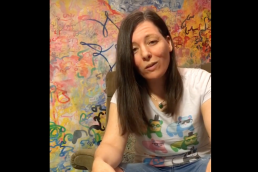by Katalina Watt
Content Warning: description of mental health institution, brief mentions of self-harm, suicide, abuse
Fearless Femme PodcastEpisode 1: Girl, Interrupted (1993) by Susanna Kaysen
Shownotes:
Music: ‘Dear One’ by Pisces is licensed under a Attribution-ShareAlike 4.0 International License.
Edition Referenced: Kaysen, Susanna. Girl, Interrupted. London: Virago, 2000. Print.
Transcript:
“Hello! I’m Katalina Watt and today I’ll be discussing Susanna Kaysen’s 1993 memoir: Girl, Interrupted. The book varies somewhat from the 1999 hit film, so we’ll be sticking to Kaysen’s memoir. The book follows 18 year old Susanna on her two year stay at McLean Hospital, between 1967-1969 where she was to be treated for depression but was later diagnosed with a borderline multiple personality disorder. The hospital’s infamous clientele included Sylvia Plath, amongst others. The book’s title is explained in the final chapter and was inspired by a painting by Johannes Vermeer ‘Girl Interrupted at Her Music’ from 1661. Kaysen explains: “Interrupted at her music: as my life has been, interrupted in the music of being seventeen, as her life had been, snatched and fixed on canvas” (p167).
A few disclaimers:
Firstly, there will be spoilers for Girl, Interrupted. Secondly, I don’t have a medical background and so my discussions of mental health come from a layperson’s perspective. I’ve tried to use inclusive language in this literary discussion, but some quotes from Kaysen’s book might use terms we consider derogatory or inappropriate today. I’ll be quoting from my edition of the text, which is referenced in the shownotes. Lastly, there are discussions of topics like abuse and self-harming behaviour, as well as depictions of mental health institutions and therapy.
Does it pass the Bechdel and Mako Mori Test?
I’m happy to say the book passes both. For those unfamiliar, the Bechdel Test was created by Alison Bechdel and Liz Wallace in the former’s 1985 comic strip Dykes to Watch Out For. The test asks whether a piece of fiction includes three things:
1) At least two female characters
2) who have at least one conversation;
3) about something other than a male character.
It’s shocking how few pieces of media meet these requirements. In Girl, Interrupted the primary cast of characters is made up of women and their dialogue is concerned with topics such as mental health and existentiality.
The Mako Mori test is named after a character from the 2013 release Pacific Rim and is credited to a Tumblr user known as ‘Chalia’. The test expands on the Bechdel requirements, asking if the fiction contains:
1) At least one female character;
2) Who gets her own narrative arc;
3) Which is not about supporting a man’s story.
Girl, Interrupted focuses on Kaysen’s struggle with her mental health and existential dread throughout her time at McLean and beyond — she gets her own narrative arc which is very much about her as a protagonist, and there are few significant male characters in the book. So it passes.
Does a character’s mental health make up their entire personality or is it part of a well-rounded character?
As a reader, it’s difficult to see any of the characters as particularly well-rounded, because their mental health is the most distinctive aspect of their personality. Their obsessive or eccentric behaviour defines their character and Kaysen’s writing style is that of a passive observer of events. It’s also important to note that Kaysen wrote the memoir almost thirty years after the experience so the conversations and events she is remembering are fictionalised to an extent. She is also an unreliable narrator, highlighting some discrepancies between her medical records and her memory. She remembers the consultation with this unknown psychiatrist taking place over twenty minutes, but her medical records note it as being three hours long. Kaysen addresses this in the narrative, speculating on her memory’s accuracy and asking the reader to decide what the truth is.
How is therapy and support for mental health issues portrayed?
Kaysen’s portrayal of treatment at McLean is generally negative. Kaysen discusses the patients’ daily routine of seeing: “the ward doctor, the resident, and [their] own therapist” (p84) and the othering of the patients by the doctors through their medical terminology. There is also a No Physical Contact rule adhered to by day staff but not night staff. Valerie, the head nurse, is the only authority figure the girls appear to trust as she neither patronises them nor treats them as otherly.
Early in the book we are introduced to Polly, a patient who has attempted to commit suicide in the past by setting herself on fire, but is now seemingly serene and accepting of her altered appearance. Although she seems that way at first, Kaysen describes the moment Polly reacts with horror at her reflection, realising “she was locked up forever in that body” (p19).
I was particularly disturbed by Lisa making jokes about Janet, an anorexic who is force-fed by staff to maintain a healthy minimum weight, Daisy’s suicide, and the seclusion room intended to “quarantine people who’d gone bananas” (p47). There’s also the electroshock therapy endured by Cynthia. Alice Calais is a naïve girl who doesn’t know how to correctly pronounce her surname and has never tasted honey. She’s eventually taken to the maximum security ward after she “explode[s] like a volcano” (p112). When the other girls visit her, they are shocked by the conditions and the deterioration of their friend, who claims to be getting better but has covered the walls of her cell in excrement. Susanna asks Georgina if they could end up like that and it’s a rare moment where Kaysen reacts with horror to the difficult events that occur around her.
How are femininity and traditionally feminine traits presented?
Traditionally feminine traits such as empathy and compassion are expressed by both patients and staff at McLean and these are presented as healthy and positive. Lisa distances herself from these traits, often acting in a hostile or solitary way. In some ways the girls shun traditional feminine traits such as sexual conservatism and passivity, but in other ways these traits are still pervasive in the book. Whilst the girls seem to have open discussions with the student nurses, who are around their age, many of the older staff represent the conservative norms of the previous generation. Kaysen references the sexual revolution, mini-skirts, and contraception, but the girls are also concerned with traditional feminine expectations of beauty, such as shaving their legs and having boyfriends.
I think an important thing to discuss is the archetype of the feminine as monstrous. Femininity has often been othered by heteronormative narratives and I think in many ways ‘unstable women’ are often portrayed as monstrous. I’m thinking here of Jane Eyre and The Yellow Wallpaper as just two literary examples. And of course it’s society which deems them mentally ‘unstable’ and we still live in a patriarchy, so if femininity is threatening, it gets controlled.
Are female characters hypersexualised?
Absolutely not. Sex is discussed openly and playfully by the girls on the ward. Kaysen reflects on being labelled ‘promiscuous’ and society trying to link female sexual empowerment with shame. Dr Wick is the head of the adolescent girls’ ward and an older woman with conservative values. She is “easily shocked about sexual matters” (p85) and Kaysen enjoys provoking her with blunt language or steamy melodramatic retellings of sexual encounters.
One of my favourite chapters in the book is ‘Checkmate’, when the girls have a frank conversation about the difficulty of having sex on the ward during checks which ranged between five and thirty minute intervals. They make jokes about their sex lives, or lack thereof, and are very candid about their experiences and preferences. There’s so much dry humour in this book and this scene was relatable, a bunch of girls chatting about life. At this point they are resigned to the regulations and controls over all aspects of their lives but they still find ways to rebel. Their sexuality is just one part of their personality, it doesn’t define them and we as the reader don’t feel voyeuristic.
Are strong female friendships represented?
I’m not sure if the female friendships are ones to be emulated. There are moments of manipulation and destruction, particularly in the wake of Lisa Rowe. Her pride at being diagnosed a sociopath, total disregard for authority, and subsequent plots to escape McLean earn her the respect of and influence over the other girls on the ward. When Lisa Cody joins the ward, they compete over their drug habits and sociopath diagnoses, having “life-history battle[s]” (p60) and comparing track marks on their arms.
However, the girls also support one another, such as the moments of genuine friendship between Kaysen and Georgina making caramels and the girls’ friendships with the student nurses. Kaysen describes the nurses as “alternate versions of [them]selves. They were living out lives [they] might have been living, if [they] hadn’t been occupied with being mental patients” (p90-91). They form an augmented society in the ward, with Kaysen often using boarding school analogies such as their group level of noise and disorder being “relative, like the grading curve in high school” (p47). Kaysen specifically says “the hospital was as much a refuge as it was a prison” (p94), discussing the liberties as well as the constraints on their lives and choices. She talks about the expense of her therapy, a bill which was being footed by her family, and a strange type of freedom from demands and expectations of the outside world.
Is the piece diverse in terms of race/LGBTQIA+/disability?
Absolutely not. Girl, Interrupted concerns the experiences of a middle class white cisgendered and able-bodied woman for the most part. Of course we must consider the book in its socio-historical context, and therefore must allow for it falling short in terms of intersectionality and inclusivity. However, whilst Kaysen’s experiences are valid and should be acknowledged, one of my major criticisms of the book is its narrow focus.
If the target audience is impressionable, does the piece display responsibility to that audience when dealing with depictions of mental health?
The target audience of the book is young women, especially considering the protagonist is 18 years old. This target audience is impressionable, and Kaysen’s book continues to have a cultural impact, especially in the wake of the wildly popular film adaptation — despite that being liberal with the source material. Kaysen’s primary motive for the book was to document her own life experiences; the book doesn’t purport to be instructive or didactic.
That being said, the subject matter and themes of the book are important ones for women of all ages, and especially younger women. When I was 18 I was hungry for books that spoke to my own experiences or even just discussed women and mental health. A book which will appeal to this demographic must take responsibility for the way it depicts mental health. To ignore that responsibility can make it part of the problem of misinformation.
Katalina Watt
Katalina Watt is a native Londoner and graduate of English Literature from the University of Glasgow. She writes fiction and hosts podcasts on books and narrative in video games. Katalina has an insatiable wanderlust, and when not reading or writing, she enjoys smashing the patriarchy and dancing to jazz.







